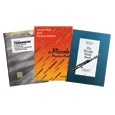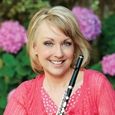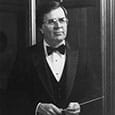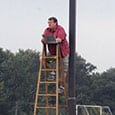I am a great believer in etude study. The methodical approach to technical challenges in a sequential manner seems to almost guarantee improvement as long as careful and patient practice methods are employed. The term etude literally means to study or research, so approach an etude as a laboratory for studying a particular musical challenge.
There are countless flute etude books that can be played on piccolo, but many exceed the range of the instrument, particularly in the low register. Three of the most common etude books that are designed just for the piccolo are The Piccolo Study Book, by Patricia Morris, A Piccolo Practice Book, Trevor Wye with Patricia Morris, (both published by Novello) and Studium Techniki, or The Study of Technique in Small Flute Playing, by Eugeniusz Towarnicki, (published by PWM, Polskie Wydawnictwo Muzyczne).
Morris’ Piccolo Study Book begins with a page of excellent suggestions for warming up that focus on the embouchure and developing the ear. Accurate intonation goes hand-in-hand with a beautiful sound, so a good way to check this is to work on long tones in thirds, fifths and octaves in a tone study using either a tuner or a piano with reliable pitch. Transposing this simple study throughout the range is invaluable.

The remainder of the book is devoted to etudes from various composers edited for the piccolo’s limited range and divided by sections emphasizing the particular concepts of sound and flexibility, articulation, fingering, ornaments, and a section called grandiose studies which emphasizes expressive, virtuosic playing. Playing an etude from each section is a nice way to reinforce concepts in a specific and directed way.
The 3rd section, Fingering, is especially helpful to students new to the piccolo. It includes cross-fingering passages to help students adjust to balancing the smaller instrument, (the keys are closer together in addition to being smaller), while keeping a smooth relaxed finger motion. The book closes with a page of useful alternate fingerings that are a mainstay of piccolo technique. Lightly annotated throughout, each etude contains an introduction that is helpful and will help students focus on the key points of the study. I have a few of these etudes memorized and use them as part of my daily piccolo warm up routine.
The Piccolo Practice Book is a wonderful resource for many reasons. Well organized by subject (middle register, articulation, tunes at the top, special fingerings, etc), this book also contains many of the best-known piccolo excerpts. There are small etudes interspersed that target the challenges of the excerpts, so that some of the practice is mapped out. The section marked Coda is a catch-all of knowledge as it lists information on purchasing a piccolo, solos and chamber music, audition lists and a practice routine. Likewise, the preface and introduction are meant to be read and contain valuable information. I especially like the suggestion to play some flute in the third octave before starting piccolo practice to help your lips remember how to downsize and hold a smaller aperture without extra tension.
The Towarnicki book is divided into sections by major keys, followed by the companion relative minor keys. Each key area includes an intonation study, articulation study, etudes, and frequently, solos and duets. A separate volume of piano accompaniments is offered for the various solos and duets that are found in the solo piccolo volume. The organization by key area is terrific for intonation work. Some of my favorite warm-up arpeggios patterns are found in this volume. Several series of major, minor, diminished and seventh chords in each key provide a comprehensive daily warm up throughout the entire range of the piccolo. The example below consists of major, minor, and diminished triads. I enjoy working on this study by adding a diminuendo as I ascend and a crescendo on the way down.

Like the Wye/Morris book, the Towarnicki book also contains excerpts from the symphonic literature as well as from opera and ballet. The only words in English in this book are the title as this book is published in Polish with a German translation. There are several other piccolo etude books worth exploring including One hundred Short Exercises for 1-2 piccolos by Tulou (Publ. Billaudot), Method Populare by Tulou (Publ. Ricordi), and Beaumadier’s Exercises (Publ. Billaudot)
General Guidelines
It is perfectly acceptable to learn the notes of an etude on the flute first. Practicing too much piccolo all at once often tires the embouchure. If this should happen, play whistle tones and harmonics on both instruments to restore a sense of balance to the embouchure. If you own an alto flute, play a few notes on it after the piccolo to really relax the lips. Intonation is critical, so keep a tuner close by and listen to the intervallic relationships between notes to work on your ear.
I try to take a break after 30-45 minutes of piccolo work to stretch, walk around, and just give my ears a rest. It is wise to use ear plugs, especially one in the right ear, to protect from the high frequencies while practicing. It also helps to become used to the ear plugs in practice rather than just using them during concerts. Lastly, it is more important to work a little bit each day than to ignore the piccolo for a week and then practice for two hours. Consistent piccolo practice is critical to teach the embouchure its new smaller position which leads to tonal stability and consistent intonation.






